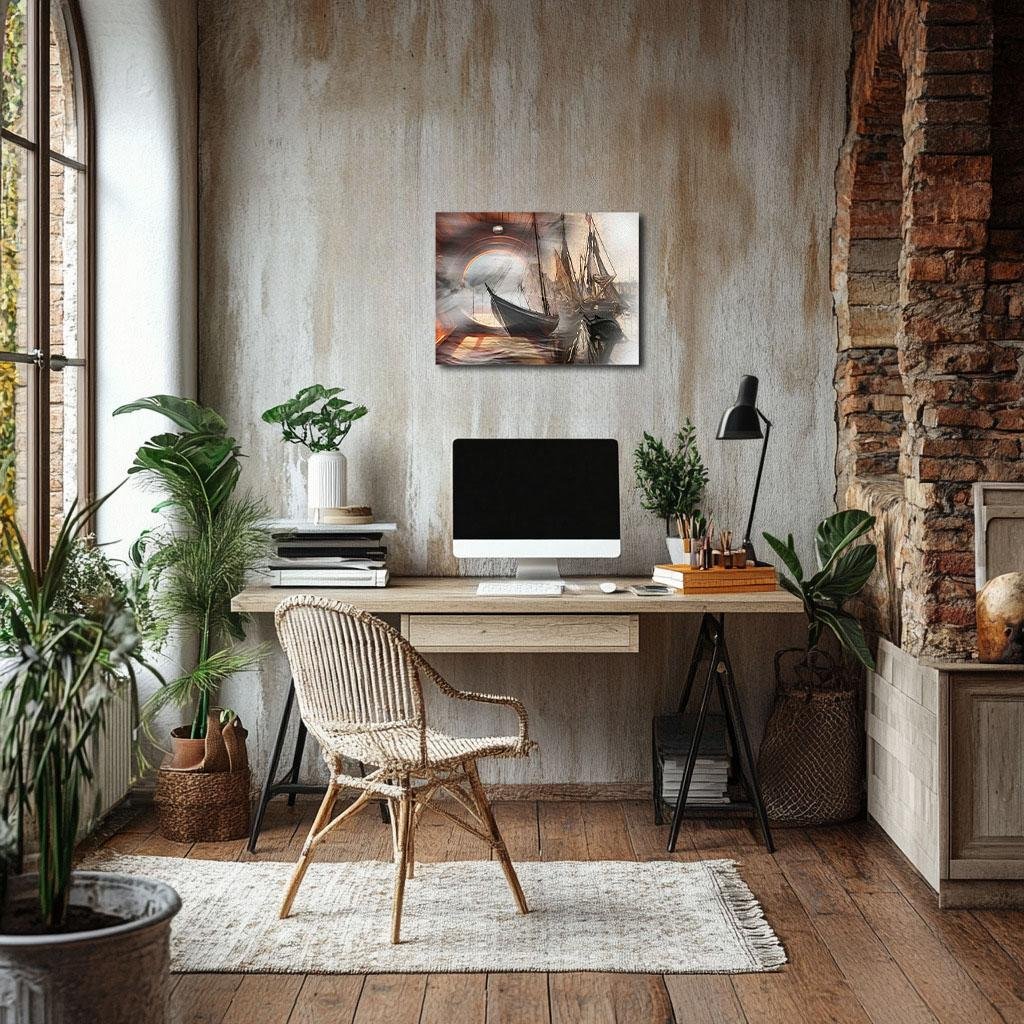Portals of Honfleur: Boats Between Memory and Wake
Portals of Honfleur: Boats Between Memory and Wake reimagines Monet’s 1867 harbor scene as a conceptual journey where fishing boats drift not only through water but through memory. A glowing portal opens the painting into layered perception, where one boat sails forward into a space of dream and reflection. This surreal collage explores stillness, motion, and how art carries us quietly across the thresholds of time.
Please see Below for Details…
Hotline Order:
Mon - Fri: 07AM - 06PM
404-872-4663
Claude Monet’s Fishing Boats at Honfleur , painted in 1867, is a study in atmosphere—anchored vessels resting in the calm stillness of water, masts rising like quiet prayers against a hazy sky. The piece, painted with devotion to light and texture, captured the spirit of a working harbor not through action, but through presence. Each boat, though unmoving, felt deeply alive, surrounded by breath and reflection. In this conceptual collage reinterpretation, titled Portals of Honfleur: Boats Between Memory and Wake , Monet’s moment of observation becomes a layered meditation on travel, time, and perception. Boats remain, but the harbor is no longer just a place. It becomes a vessel for emotion, memory, and transit between the seen and the remembered.
On the right side of the composition, Monet’s original palette remains close to its source—grays, ochres, and soft blacks render sails, ropes, and still water with painterly restraint. The boats cluster together, their hulls dipping slightly in the current, their sails hanging slack. The mood is one of readiness without urgency, the expectancy of motion held in delicate pause. Reflections in the water are not mirror-perfect—they ripple with the imprecision of memory, of vision softened by salt air and light filtered through mist.
Yet this harbor is no longer fixed in the 19th century. It has expanded, tilted, and opened into another dimension—one rendered in sweeping curves, radiant light, and impossible architecture. The left half of the image reveals a vast circular portal, like the view through a porthole or the interior of a vessel that travels not only across seas, but through layers of perception. The curvature of the frame wraps the scene like an eyelid around a dream, suggesting that what we see is not a moment, but a remembered fragment, held carefully within the architecture of time.
A single boat pushes forward from the harbor’s memory into this portal. It is both painted and rendered, its hull trailing motion like a ghost. The angle of its bow suggests movement not through water, but through understanding. It leaves the gentle companionship of the other ships to become something singular, something exposed. The light inside the portal is warm—sunset hues bend and slip across polished surfaces, mixing with fog and sea spray in ways that do not obey gravity. This is not atmosphere as Monet painted it, but as dream evokes it.
The boundary between the harbor and the portal is deliberately porous. Fog drifts between them like memory itself—thick in places, vanishing in others. Masts cross into light and disappear. Shadows extend in strange directions, as if time were folding inward. The viewer is caught between observation and immersion, unsure whether they are looking at boats departing, or boats already gone.
The circular window, glowing with an impossible horizon, becomes a symbol of passage. It may be the view from a ship, or a vault for memory. It may be the inside of a machine built to contain moments, or the edge of the mind where vision meets reflection. What matters is that it holds both movement and stillness in the same breath. It asks the viewer to imagine that the boats are not simply waiting for tide, but for remembrance—for the moment when someone, somewhere, will see them again and make them move.
Color in this reinterpretation is used with deliberate tension. The right half retains Monet’s naturalism—muted, honest, earthy. The left, however, shifts toward warmer, abstracted tones—burnt orange, amber glow, soft silver. These colors do not blend, they converse. They ask the viewer to move between them emotionally, to recognize that time has color, and so does memory.
As the artist, I approached this collage not as a reconstruction, but as an echo. Fishing Boats at Honfleur never aimed to dramatize. It sought truth in quiet forms, in patience, in light held just long enough. This reinterpretation does not amplify that truth—it reveals the dream that always hovered behind it. The boat entering the portal does not leave the painting—it enters the viewer. It carries with it the textures of rope, the scent of weathered wood, the sound of rigging brushing mast. It becomes a vessel for remembering how stillness can be movement when painted with care.
In Portals of Honfleur , the boats are no longer only fishermen’s tools. They are metaphors for transition, containers of thought, travelers through layered perception. The harbor remains, steady and silent. But one boat drifts forward—not for catch or coin, but for connection. It reminds us that to sail is not always to leave—it is sometimes to return, through memory, through art, through light.
Add your review
Your email address will not be published. Required fields are marked *
Please login to write review!
Looks like there are no reviews yet.








